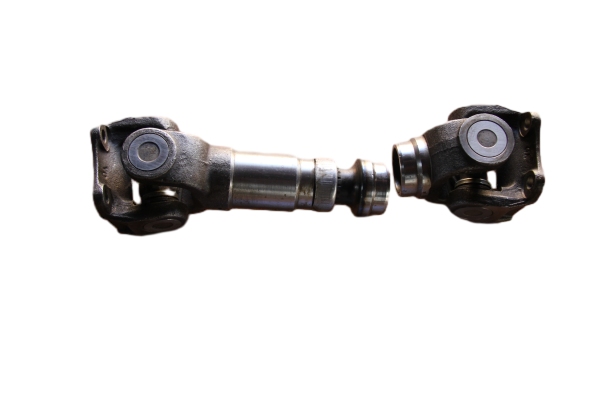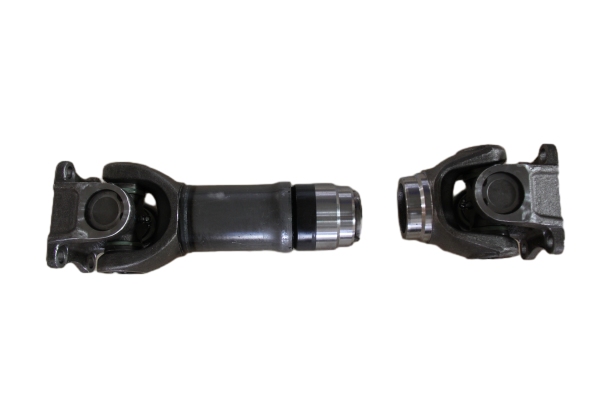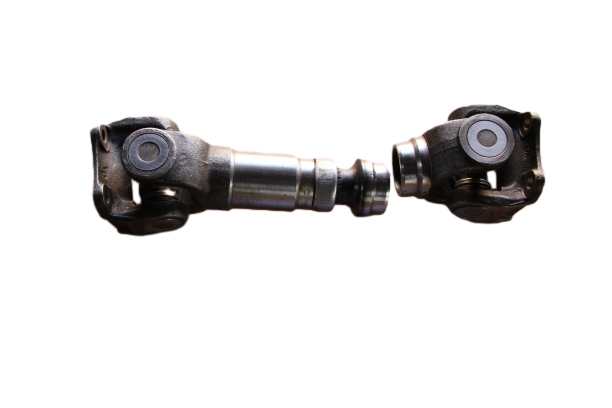
Transmission shafts are pivotal components in the drivetrain of vehicles, serving as the link between the transmission (or transfer case) and the driven axle. Their primary function is to transmit torque from the transmission to the axle, which ultimately drives the wheels. In this comprehensive guide, we will explore the various types of transmission shafts, the materials used in their construction, design considerations, manufacturing processes, and essential maintenance practices.

Mercedes-Benz Transmission Shaft
Types of Transmission Shafts
Transmission shafts can be categorized into two main types based on their structure: hollow and solid.
-
Hollow Shafts: These are the most common type, especially in commercial vehicles. They are typically made by rolling and welding thin steel plates to form a tube. This design is not only cost-effective but also lightweight, which is crucial for fuel efficiency and performance.
-
Solid Shafts: Used in specific applications such as steering drive axles, disconnectable drive axles, or in miniaturized vehicles, solid shafts are made from solid bars of metal. They offer greater torsional rigidity and are less prone to bending under heavy loads.
Materials Used in Transmission Shafts
The choice of material for a transmission shaft is critical, influencing its strength, durability, and performance. Common materials include:
-
Steel: High-strength steel alloys like 4340 or 4140 are often used due to their excellent balance of strength and ductility. They are suitable for high-load applications and can withstand the rigors of daily driving.
-
Aluminum: Lighter than steel, aluminum alloys such as 6061 and 7075 are used in applications where weight reduction is crucial. They are commonly found in performance vehicles and light-duty trucks.
-
Titanium: Known for its superior strength-to-weight ratio, titanium is used in high-performance and luxury vehicles. It offers excellent fatigue resistance and durability, though at a higher cost.
Design Considerations
Designing a transmission shaft involves several critical considerations to ensure efficient power transmission and reliability:
-
Torque and Power Handling: The shaft must be designed to handle the maximum torque and power that it will transmit. This determines the required material strength and shaft diameter.
-
Balancing: To minimize vibration and ensure smooth operation, the shaft must be balanced. Unbalanced shafts can cause excessive wear on bearings and other drivetrain components.
-
Flexibility: The shaft should have enough flexibility to accommodate misalignment between the transmission and the axle without excessive stress.

Beijing 212 Transmission Shaft
Manufacturing Processes
The manufacturing of transmission shafts involves several stages, from material selection to the final product:
-
Molding: For hollow shafts, the material is rolled into a tube and welded to form the desired shape.
-
CNC Machining: Computer Numerical Control (CNC) machining is used for precise shaping and finishing of the shaft. This includes processes like turning, milling, and drilling.
-
Heat Treatment: Heat treatment processes such as quenching and tempering are used to enhance the hardness and strength of the shaft material.
-
Surface Finishing: Final processes like polishing, coating, or grinding improve the shaft’s resistance to wear and corrosion, ensuring a longer service life.
Maintenance and Troubleshooting
Proper maintenance is essential to ensure the longevity and reliability of transmission shafts. Here are some common issues and their solutions:
Vibration and Noise
Symptoms: Noise and vibration during vehicle startup, especially noticeable when changing speeds.
Diagnosis: Lift the rear wheels and start the engine to observe the shaft’s behavior at high speeds. Check for signs of bending or loose balance weights.
Causes and Solutions:
-
Unbalanced Shaft: Balance the shaft or replace it if necessary.
-
Bent Shaft: Straighten or replace the bent shaft.
-
Loose Components: Tighten or replace loose universal joints or bearings.
Whining Noise
Symptoms: Abnormal noise from the vehicle’s undercarriage during operation.
Diagnosis: Check for signs of wear or damage in the universal joints and bearings. Firmly grip the shaft and check for excessive play.
Causes and Solutions:
-
Worn Bearings: Replace worn-out bearings.
-
Loose Fasteners: Tighten loose bolts or nuts.
-
Damaged Components: Replace damaged parts such as the output shaft or universal joints.
General Maintenance Tips
-
Avoid High-Speed Starts: Using high gears to start can put undue stress on the shaft.
-
Smooth Clutch Operation: Avoid abrupt clutch engagements to prevent shock loads.
-
Regular Inspections: Regularly check the shaft for signs of wear, damage, or misalignment.
-
Lubrication: Ensure that all moving parts are well lubricated to reduce friction and wear.
-
Balance Checks: Regularly check the balance of the shaft to prevent vibration issues.

Dongfeng, Jiefang, and Jianghuai Transmission Shaft
Conclusion
Transmission shafts are critical components in the vehicle’s drivetrain, playing a vital role in power transmission. Understanding their types, materials, design, and manufacturing processes is essential for selecting the right shaft for your vehicle. Regular maintenance and timely troubleshooting can significantly extend the life of these components, ensuring reliable and efficient vehicle operation. By following the maintenance tips outlined above, you can help prevent costly repairs and keep your vehicle running smoothly for years to come.
In conclusion, the transmission shaft is more than just a mechanical part; it is a symbol of the intricate engineering that goes into creating reliable and efficient vehicles. As technology advances, we can expect to see even more innovations in shaft design and materials, further enhancing vehicle performance and durability. Whether you are a vehicle owner, a mechanic, or an automotive enthusiast, understanding the transmission shaft is a crucial aspect of appreciating the complexity and beauty of automotive engineering.

